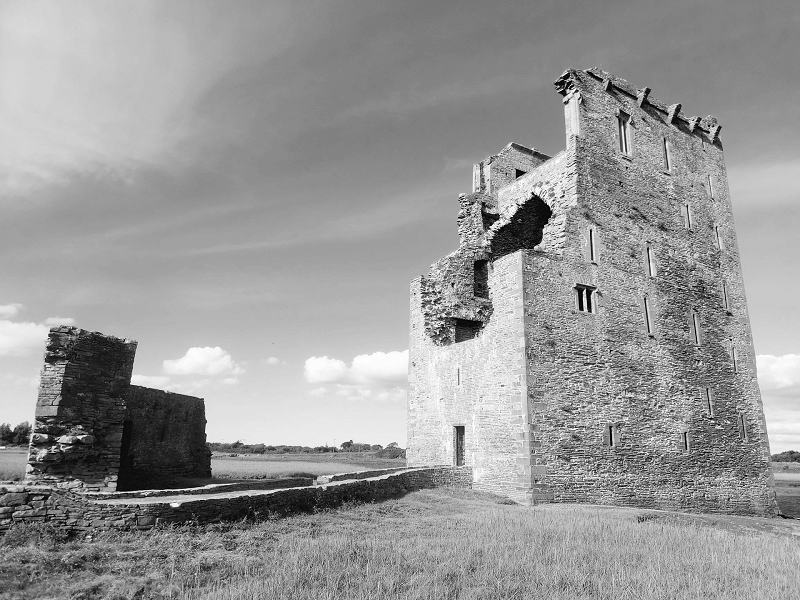History

When it was built in 1490 commissioned by the wealthy O’Connor family,
it was one of the largest and best defended tower house in Kerry [1].
Located near Ballylongford on the Shannon Estuary, County Kerry [2],
it was once considered the "Guardian of the Shannon" river, due to its position overlooking the shipping lanes from and to Limerick and
its name Carrig an Phoill means “rock of the hole” [2, 3].
Probably, the name is due to the fact that the castle is perched on a rock on the edge of the water [4].
It consists of a five storey tower house, almost 90 feet high, with a 104 step spiral staircase leading to the battlements [1, 3].
The internal wall enclosed a bawn, surrounded by a moat covered on three sides by the external wall, with a smaller tower [2].
Conor Liath, who was responsible for building the castle, died about 1523 and was succeeded by his son Conor Fionn [1].
From then till 1580, the power and wealth of the family grew thanks to the castle at Carrigafoyle,
that gave them control over the commerce along the Shannon river, and to several alliances that the family
made with both Anglo-Irish and Gaelic families [1].
In 1568, Conor Bacach O’Connor Kerry, son of Conor Fionn, took part in the battle of Lixnaw, to support the Earl of Desmond
and his chief military leader James Fitzmaurice Fitzgerald against the Fitzmaurice of Lixnaw, but was killed during a siege [1].
As Carrigafoyle was a strategic fortress, the Earl of Desmond granted the castle to James Fitzmaurice, who married Hanora O’Brien,
widow of Conor Bacach O’Connor Kerry [1].
The second Desmond rebellion started in 1579, when James Fitzmaurice Fitzgerald, kinsman of the Earl of Desmond, Gerald FitzGerald,
declared war again Queen Elizabeth and her representatives in Ireland (Second Desmond Rebellion) [1, 5].
The O’Connors of Kerry were involved in the war, obliged to fight for the Earl of Desmond.
Due to its strategic position, the tower house at Carrigafoyle was attacked by the English army [1].
As a result, on Palm Sunday, 1580, Carrigafoyle was besieged from the landward and seaward by the troops of Sir William Pelham,
with 600 soldiers [1, 2, 4].
The English forces attacked the castles with three cannons and, after being bombarded for two days, the walls crumbled and the tower cracked,
allowing the Elizabethan soldiers to flood in [1].
All inhabitants (50 Irish soldiers, 16 Spanish soldiers who had only recently arrived at the castle, captain Julian,
the Italian engineer commanding the garrison and responsible for strenghtening the castle defenses, and the civilians,
including women and children) were either killed during the siege, or hanged or put to the swords shortly afterwards [1, 3].
As a result, other Desmond strongholds felt discouraged from opposing resistance to the invaders:
The castle at Askeaton was abandoned, and the garrisons at Newcastle West, Balliloghan, Rathkeale and Ballyduff fled soon after [2].
The fall of Carrigafoyle was the beginning of the end for the Earl of Desmond: He was finally captured and killed in the woods of Glenagenty,
near Tralee, in November 1583 [1].
Another version of the story says that one of the O’Connor Kerry’s maid servants committed treason
by placing a candle in the weakest window of the castle, to direct the cannon fire [1].
It is reported that also this girl was slaughtered after the siege [1].
Sean na gCathach, still young when his father Conor Bacach O’Connor Kerry died, as many others, abandoned the Earl of Desmond after
the fall of the tower house and managed to survive, although he lost Carrigafoyle [1].
He did retake Carrigafoyle before 1600 but after that the rebellion of Hugh O’Neill, Earl of Tyrone, and Hugh O’Donnell, Earl of Tyrconnell,
broke out and Sean na gCathach, understanding that the Lord President of Munster, Sir George Carew, intended to occupy the castle,
handed it to him [1].
In December 1601, Sean retook Carrigafoyle again, and ‘the English ward, who had been left in it with a guard, was murdered’ [1].
The war continued and, after being defeated at Kinsale, Sean joined his kinsman, O’Sullivan Beare, at his stronghold at Dunboy, County Cork,
that was under siege in 1602. Unfortunately, Irish were defeated at Dunboy and the 'O’Sullivan Beres March' started,
with the defeated forces walking for 215 miles, from Dunboy to O’Rourke’s castle in Leitrim [1].
The march started in December 1602 and, out of one thousand people, only 35 reached the destination, including Sean [1].
The rest of the story says that Sean recovered and then went to Scotland to meet the new king James VI who accepted to reinstate Carrigafoyle to him,
for being one of the greatest of the old Gaelic aristocracy [1].
Therefore, Sean na gCathach returned to Carrigafoyle, where he died in 1640 [1].
As he had five daughters but no sons, his titles and estates passed to his kinsman, Donal Maol O’Connor [2].
In 1649, while held by John O’Connor Kerry (Sean an Fíona), Carrigafoyle was besieged again during the Cromwellian invasion and eventually fell [1].
The tower was finally destroyed and the outer walls were taken down [1].
The battered structure that can be visited today is a snapshot of what has been left after those cruel days.
Sean an Fíona was captured and executed in Tralee’s market square [6],
as a final act of the associations of the O’Connor Kerry with Carrigafoyle [1].
In 1649 some of the lands around Carrigafoyle were granted to Lancelot Sandes and in 1666 the English crown confirmed the grant of all the estates
to the Provost and Fellows of Trinity College Dublin [1].
Carrigafoyle Castle is now a listed National Monument, managed by the Office of Public Works and, in recent years, the castle had hosted the O’Connor Kerry Clan gatherings [2].
It has been partially restored and now it is open to the public during some months of the year [2].
References
- [1] Storied Kerry, Carrigafoyle: History and Memory
- [2] Patrick Comerford, Carrigafoyle Castle: a castle with a commanding position on the Shannon estuary
- [3] Orna Mulcahy, "Irish Castles", Collins Little Books, 2020
- [4] Irish Expressions, Carrigafoyle Castle
- [5] Wikipedia, Siege of Carrigafoyle Castle
- [6] Ballylongford snaps, Carrigafoyle Castle








